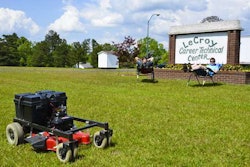 Source: Chicago Botanical Garden
Source: Chicago Botanical GardenLiving pictures — cuttings of assorted succulents woven together in everything from picture frames to pallet boxes — have caught on among garden designers and landscapers this spring as an easy, modern way to add color and texture to an outdoor space.
Living pictures are also nearly maintenance-free (i.e., hard to kill). So even beginners or those with the blackest of thumbs can look like the master gardener of the neighborhood.
Take Cuttings
Almost any succulent can be used for living pictures, though it’s usually best to stick with varieties that stay small, like echeverias and sempervivums, says DIG Gardens co-owner Cara Meyers.
“It’s fun to use varieties of aeoniums and sedums for their fun colors and textures, but they may need a little more maintenance, as they may start to grow out of the picture more,” she says.
Cut off small buds of the succulents for cuttings, leaving a stem at least 1/4-inch long.
Make sure old bottom leaves are removed, then leave the cuttings on a tray in a cool, shaded area for a few days to form a “scab” on the ends before planting.
Add Soil
Set the frame mesh-side up on a table and fill with soil, using your hands to push it through the wire mesh openings.
Be sure to use cactus soil, which is coarser than potting soil, for better drainage.
Some vertical gardeners place a layer of sphagnum moss under and over the soil to hold moisture in when watering.
Fill with Plants
Lay out the succulent cuttings in the design you want on a flat surface, and poke them into the wire mesh holes in your frame.
You can start either in one corner or by placing the “focal point” cuttings in first and filling in around them. Waves or rivers of color are popular living-picture designs, although Cape Cod-based landscaper Chris Lambton has gone bolder with spirals of green and purple.
“We painted the pallet different color stripes to go with the color theme of the back of the house,” says Lambton, host of HGTV’s “Going Yard.” “It looked like a cool piece of living, reclaimed art.”
Using just one type of succulent is also a simple yet elegant option, says Kirk Aoyagi, co-founder and vice president of FormLA Landscaping.
“Collages with some draping and some upright plants can create a more dramatic look and feel,” he says.
Care and Maintenance
Keep the living picture flat and out of direct sunlight for one to two weeks to allow roots to form along the stems, then begin watering.
“If you hang it up right away or it rains a lot, that dirt will just pour right out. … I made that mistake once,” Lambton says.
Mount your living art once the succulents are securely rooted, which can take four to eight weeks depending on climate.
After that, water every seven to 10 days by removing it from the wall and laying it flat. To avoid rotting, be sure to let the water drain before hanging your living picture back up.
– The Associated Press










